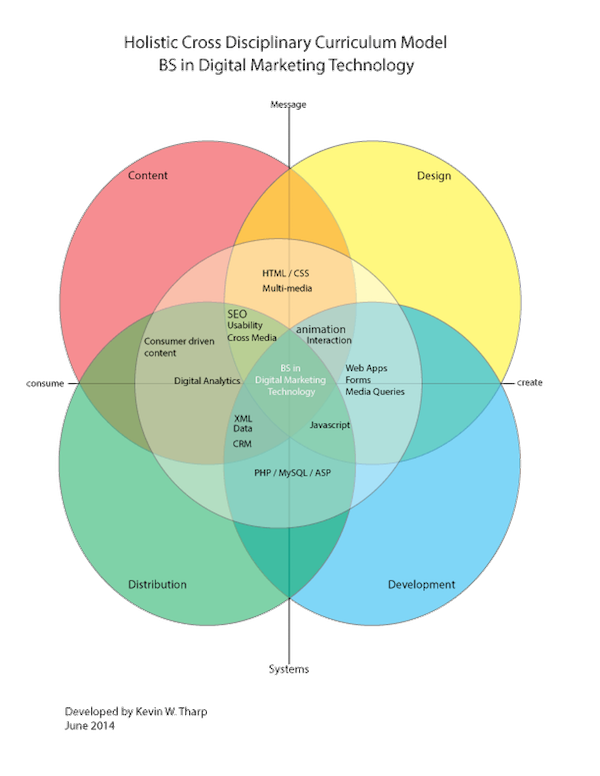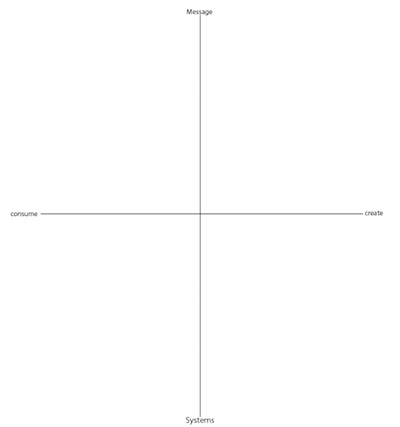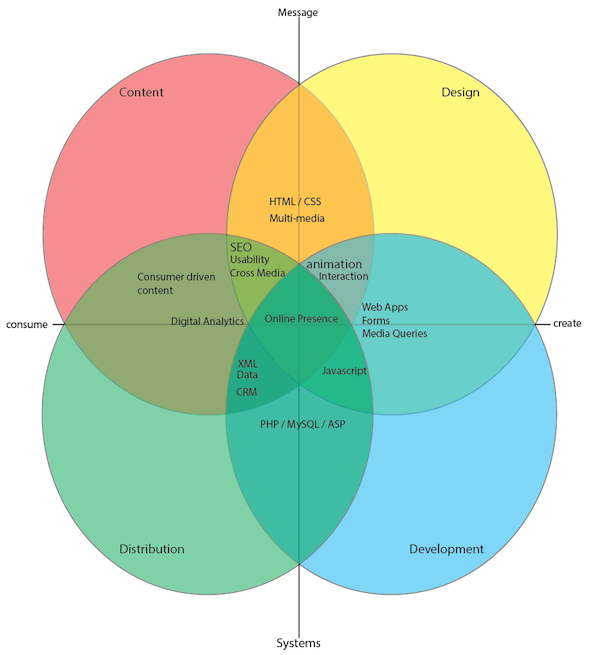Today’s guest post is written by Dr. Kevin W. Tharp, an associate professor of digital marketing technology at the University of Wisconsin-Stout — and the founder of the first ever Bachelor of Science in Digital Marketing Technology degree.
The Bachelor of Science in Digital Marketing Technology was approved by the University of Wisconsin Board of Regents in June 2015, is an online degree and is now accepting applications for the Fall of 2015. For more details about the degree, visit the program’s website.
I invited Kevin to share his thinking behind the design of the program, and more broadly, his thoughts about how the relationship between education and industry is evolving in an environment of increasingly accelerated change.
A Framework for Visualizing Marketing Technologist Competencies
If you are reading this, you probably know about the convergence that has taken place around marketing technology. I do not need to tell you about the talent and skills gap, or the dearth of people who understand both the technology side and how it intersects with the modern marketing function. As I sat in the MarTech conference in Boston last summer listening to people like Paul Roetzer, Sheldon Monteiro, and Erica Seidel, it was clear that the talent pipeline coming out of higher education had not adapted to the rapid change, and it was not, for the most part, addressing the needs of the new marketing technology paradigm.
I also knew the challenges facing higher education in adapting to such a rapidly changing environment because I had been up to my eyeballs in developing what was to become the first B.S. in Digital Marketing Technology. Let’s face it, education was not the model for agile methodology. However, education, like every other enterprise, faces the very real probability that business as usual is not a path to success.
The focus of this article is on the core competencies, how to map them, and establishing a framework that will adapt as the core competencies change. The article then looks at changes in the way people learn about marketing technology competencies, the challenges of teaching such rapidly changing areas, and the role of industry in helping students to learn the field of marketing technology.
The framework was created to support the development of the degree, but it can be useful in understanding the bigger picture of areas of competencies within the realm of marketing technology and possibly serve a role in your talent development or recruitment strategies.
A framework for mapping core competencies
Whether you are looking for a marketing person that understand technology, or a technology person that understands marketing, there are 4 overlapping facets that they need to understand that collectively encompass online presence. Those facets are:
- Content
- Design
- Development
- Distribution
To understand the relationship of these facets from a competency and theoretical perspective, we turn to a model to help visualize the relationships. Any time you start using models, there are exceptions and contradictions, but this will give us a place to start the conversation and place the competencies into the overlapping areas. We start with a set of axes upon which we will graph the relationships.
The X axis is a focus on process. On the left, we have the process of consumption, or how do people use our stuff. On the right, we have a focus on the process of creation, or how do we make the stuff.
On the Y axis we have a focus on communication, ranging from a focus on the message on the top to a focus on systems on the bottom.
Combined, they create a graph with four quadrants that we can use to map those four facets of marketing technology.
So for example, in the top left we have content. When teaching skills in this area, message is of greater importance than systems, and consumption is emphasized more than creation. Activities in this quadrant focus on messages and understanding the consumption process of those messages by end users.
In the top left sits design, where message and creation are the ruling areas of focus. In this area, presenting messages and understanding the process for creating those messages are the primary goals of activities in this quadrant.
The bottom left is the domain of distribution, where systems are more important than messages, and consumption emphasized more than creation. Here systems and understanding how to use those systems for the process of consumption are the primary goals.
Bottom right is for development with an emphasis on creation and systems. So here, we have a strong focus on the systems and the creation of the elements of those systems.
You will notice in the image that the four facets do not fit snuggly into one of the quadrants. The facets overlap each other in a manner that allows each of them to interact with the others. This is where we can begin mapping competencies. Within each of these areas of overlap, we find knowledge or skill sets that are part of the marketing technologist’s arsenal. The overlap of content and design finds HTML and CSS, multi-media, and you could find others that would map to this area of overlap.
In the overlap of design and development, we find web apps, forms, media queries, etc. The confluence of content and distribution finds consumer driven content and digital analytics, and the overlap of distribution and development finds the realm of the application servers such as PHP, MySQL, and ASP.NET.
But where the rubber really starts to hit the road is in those areas that have three or more overlapping facets. These are the areas where overlapping skill sets can lead to performance. For instance, in the overlap of content, design, and distribution, sit competencies such as SEO, usability, and cross-media or omni-channel messaging. In this realm, the presentation, the messages, and the methods of distribution come together with a heavy focus on message consumption that also relies on knowledge of systems and creation.
The areas where three of the four facets overlap are approaching the sweet spot of online presence. For instance, animation and interaction sit in the content/design/development overlap. XML, usage data, and customer relationship management (CRM) systems sit in content/distribution/development intersection. And of course elements like JavaScript and other scripting languages integral for design and distribution sit in the distribution/design/development overlap.
Brought together, you are able to start to visualize the myriad of competencies that are part of the world of the marketing technologist. Some of the competencies are likely to change, replaced by other competencies that fit into the same area of the graph. That is the nature of this business. Nevertheless, by providing an underpinning framework, this model gives us the ability to look at the realm of marketing technology as it changes and grows and to fit each competency into a place in the grid based upon the emphasis on either creation or consumption, and message or system.
Based upon this model, at the University of Wisconsin-Stout, we developed the first ever BS in Digital Marketing Technology, with the area of curriculum represented by the central white circle. This takes a holistic approach, requiring students to take courses from across the various facets, and it also requires courses that stitch it all together in a way that is meaningful to the student. This is one model of education, but more and more there are as many paths to knowledge as there are people wanting to learn.
Evolution of Education
The delivery of education is one of the areas changing for the same technology-driven reasons that marketing has changed: consumers are demanding change, and they will go to the place that can meet their needs.
When you enter many college classes today, the makeup of the people in that class is likely going to be very different from the traditional 18-22 year old. Students come from all demographics and range from the youth who has no idea where they are going in life to the grandmother who has already lived a full life and has returned because she wants to learn something she does not already know. The same diversity exists in economics status, race, religion, gender orientation, and any other demographic you could consider. Each of them comes with their own story, their own needs, and their own expectations about what they are going to get out of the education process.
While there is an ideological debate about whether a student should be considered a learner or consumer of education, there is no doubt that there is a lot of learning that is going on in many different ways. Public and private universities, for-profit course access, video-driven tutorials such as YouTube or Lynda.com, open education initiatives, one-on-one instruction, intra-organizational learning initiatives, massive open online courses, how-to books, and who knows what else all exist because people want or need to learn.
There is no one right way to do education, and each option has its strengths and weaknesses.
Most of the people I have spoken to who are working in the marketing technology realm have some kind of a college degree, but knowledge is often more valuable than how you obtained it. The vast majority of them have said that they transitioned into the marketing technology realm because they had developed real-world applied knowledge of the field by circumstance, which means they knew a bit about some aspect, and that made them the best-qualified person. The rest they had to learn on the job — or by developing a personal learning strategy for picking up the new knowledge and skills.
Often this is “just-in-time” learning, and it has been a driving force in coping with the rapid change in the increasingly technology driven world of modern marketing. In the process, they are picking up skills from across the four facets of the model above and becoming self-made unicorns.
While just-in-time learning provides access to learn specific competencies, they are generally learned in isolation from the relationships they have with the other competencies in the greater scheme of things. A more holistic approach that helps make the association between the specific skills and the role of that competency in the enterprise is often the gap in this method.
Other places have recognized the complexity and challenges of hiring people with the desired skills and have created in-house learning opportunities. An example of this is SapientNitro’s Chief Marketing Technology Officer University. Through this type of process, businesses are trying to develop homegrown unicorns. The advantage to this type of program is exposure to professionals from across the facets who are there to bring you the big picture. However, most organizations are not offering this type of opportunity for their employees.
The other approach that will likely begin to get traction in the coming years is by developing the higher education pipeline of students and graduates who were provided a holistic, cross-disciplinary and systematic exposure to curriculum that crosses the various facets. It will start as a trickle from schools who already have curriculum across the facets and internally agree to build degree programs that cross disciplines and focus on the types of skills that industry wants to see out of graduates.
I may have mentioned that higher education was not the model for agile methodology. It will be challenging to get up to speed with these types of programs. The often silo-based nature of academia can make this a challenge. There are student-centered schools that have already recognized the need to provide opportunities for their students to get a holistic education encompassing exposure to content, design, development, and distribution. As student demand for such programs grows, the number of programs will grow as well.
Challenges to teaching and industry’s role in education
If you are a professional marketing technologist, you recognize the difficulty of staying current in any one of the specializations that have emerged in the field when you are working in the field full-time. The challenge for higher education is that our students need to learn the state of the field as it is today, but be prepared to keep that knowledge current so they are not obsolete by the time they hit the job market. Part of that challenge is in putting instructors in the classroom who have current base knowledge and working knowledge of strategies and tactics used in the industry.
The traditional model has full time professors who are in charge of the courses as the content experts. However, this model does not work when you have an environment where, say a Google algorithm update changes things overnight. In courses where there is that kind of volatility, curriculum needs to be developed that teaches the base theory, but also provisions for the injection of current knowledge, trends ,and forecasting as the field changes.
That means that a healthy and active partnership between industry and education is cornerstone.
For us, that means that we are leveraging long-standing relationships with organizations that have been part of our industry advisory board in related areas, building and developing new partnerships as we move forward. We did not wake up one day and say, “Hey, let’s create a new degree in digital marketing technology.” This evolved over a four or five year period of listening to our industry partners telling us what direction the field was going and acting on that information.
In 2009, we worked with FindLaw, a Thomson Reuters company, to develop the curriculum for our first web analytics course. Since that time, their commitment to the program of knowledge and resources has been a driving force in allowing us to move forward and ultimately to make the decision to create the new degree.
In 2012, we continued that relationship by developing a search ngine optimization course. But by the time we launched the SEO course, it had become abundantly clear that the old model of having a full-time professor teaching all of the content related to SEO was not one that was going to work. When we launched that class in the fall of 2013, FindLaw provided us with nine guest instructors who were each specialists in one topic related to what we had outlined as fundamental knowledge for an SEO course. Each of those guest instructors developed materials to teach a module on their topic and presented them to the class.
We have gone through three iterations of the course, and it is now maturing but still evolving with the industry. I am personally the instructor of the course, and I now teach the foundational content for the class, which is a little over half of the course. Then, we have the guest instructors teach specific, rapidly changing topics, where they explain the principles of their topic, followed by instruction on tactics currently being used, and culminate with a session on how the area is changing and looking forward to forecast where it is likely to go and why. These topics include areas like local, PPC, social, and video.
Imagine if we were teaching these topics with information that was a year or two years old. In many cases we would actually be teaching them how to create a disaster. We consider it as important to show the students how to stay current, as it is to teach them specific tactics. The tactics are useful in understanding how it works today, but they are likely to be outdated by the time the students send out their first resume. In each module, we point the students in the direction of thought leaders that they will need to follow if they are going to stay current.
One of the biggest challenges we face is in access to real data, because face it, unless you are working with real information you are limited in how much you can learn. To address this problem, we again turn to industry.
Continuing with the SEO class as an example, each student works with a partner organization for the duration of the SEO class, during which time they do an online presence audit of the organization. We have specific guidelines about what organizations can participate based upon the need for students to learn about the topics of the class.
For instance, to be a partner organization you must have an active web presence, not currently have full-time staff dedicated to SEO, and have a geographic presence. If you do not have an active web presence, there is limited utility to doing an audit. If you already have a SEO staff, then theoretically there would be little for the student to uncover. If you do not have a geographic presence, then the students do not have the opportunity to learn about the process for gaining access and control of online local listings.
That means that each semester, we are relying on a number of organizations to work directly with a student so that the learning can occur. It also means that each semester, for each student in the class, another partner organization is exposed to the breadth of SEO topics covered in the course. It also means that the guest instructors, the partner organizations, and the students are able to establish relationships while the students are still in the pipeline. Everybody wins!
From an industry standpoint, if you are not pleased with the skills base that is coming out of education, you have the ability to do something about it. Contact the programs that are most likely to feed into your applicant pool and see if they are willing to have a conversation about the competency sets you would like to see in your applicants. If they are willing to listen, and you are willing to commit resources to developing the solution, then you have the beginning of a symbiotic relationship. If they are not interested in the conversation, then look to other schools that are more into industry partnerships.
As I watch public funding being pulled out of the higher education system, I personally have to believe that increased partnership between schools and industry is going to be one of the solutions to keeping our academic standards high and producing the educated population that our nation and the world needs to thrive.
This is not a new model. Industry and education have been working together forever. What is new is the speed of change. Industry has the ability to have an impact that influences the quality of education, while maintaining the integrity of the educational institutions and their missions.
Thanks, Kevin!







Great description, I really appreciate the drive towards educating and creating more marketing technologist professionals. One suggestion would be to call out automation technologies (drips, flow actions, etc.) in the bottom right corner of the online presence segment of the diagram since it’s definitely a key tool in the toolbox of not only capturing/transforming leads but also helping to deliver crucial insights to the organization.
Again, great blog entry.
Jeff
Jeff. The diagram isn’t meant to be all inclusive, but rather to provide the framework for placing core competencies. You have done what it is meant to allow, and expanded it for a specific set of competencies you view as essential. I appreciate the feedback.
I really like the diagramatic articulation of the martech ecosystem, it summarises all the stuff going on really well.
Like you, I see a real shortage of skills and talent, but the ecosystem is changing so quickly, and so unpredictably, that the balance between learnt skills, and the ability to “think” will be tricky.
I tend to think that the weight should be on the “thinking” side, and I advise all my clients to hire not for what is on a resume beyond demonstration of foundation skills required, but for curiosity.
A curious person will go out and find the information required to get something done, and will be receptive to new stuff.
Absolutely, I couldn’t agree more. When I am asked about who will do well with this major, my response is that they need to be people who can function on both left and right brain levels, are curious, and enjoy constant change.
It’s nice to see this role of Marketing Technologist has finally come into focus. After years of performing this tireless role I suspect many of us were starting to have an existential crisis. 😉
Something that should be added to this curriculum is scrum. I would consider having students run sprints in teams while learning new project management philosophies. That would give them insight into managing deliverables in the 21st century and how to work as a team to achieve complex goals. This mix is good. Just needs PM added.
I hesitate to enter the PM debate over which philosophies should be emphasized as it is not my area of expertise. But your point is well taken. In our courses, they are required to take project management, and they are exposed to it in the various development courses as well. I think in the end, the most important thing to have the student take away is an understanding that there are different philosophies and that each comes with its own strengths and weaknesses.
Congrats on the new program! Certainly a step forward for higher education, and a tremendous opportunity for students looking to differentiate themselves in the market. Excited to see how this develops.
So happy to see the need for Marketing Technology education being addressed! Please consider including courses focused on data management and stewardship. A critical component of creating successful Marketing and Enterprise Customer Interaction Management capabilities is access to a variety of relevant, applicable data sources that are understood and easily accessible. It’s imperative that key business decisions made using Marketing Technology are based on a comprehensive, trustworthy set of information. (Decisions made using an incomplete picture of the customer, organization and landscape can be not only flawed but fatal.) A combination of transaction data, interaction data, customer profile information, and environmental (e.g. competitive and economic landscape) information provides the necessary foundation for good decision making. While data sourcing and preparation should likely remain IT focused tasks, the Marketing Technologist organization should include data specialists who understand: what data should be used for specific business purposes, where the data resides, how to access the data, and what the quality and reliability of the data is. A understanding of data management concepts is a skill that I would look for in hiring a Marketing Technologist.
There is no denying the importance of data and all that comes with it. If I were going through this program myself, I would find a way of getting a minor in data (or a second major). In the end, you hit on the challenge in the use of the term “data specialists”. We are limited in how much we can teach, we have only 120 credits and 40 of those are taken by general education. Our intent in designing this major was not to create specialists, but rather to create people who could come into a team with a broad general knowledge with primary emphasis on enterprise and web technologies. We leave room for specialization with 18 credits aimed at allowing for the development of a second vertical specialization. We encourage them to seek a minor for this reason. But in the end, you can’t develop someone who understands the bigger picture and is a specialist in something like data when you only have so many credits. Some of that will have to happen on the job, and some of it will be developing the ability to communicate with the specialists. Much of education is focused on developing specialists, and that was precisely the reason we were told by our industry partners that a degree that spanned the breadth of the marketing technologist world was needed. You can hire marketing specialists, designers, programmers, data specialists, and system specialists. But how hard is it to find a fresh college grad who has an understanding of each of these realms. Granted, the definition of “understanding” is somewhat limited, but they should at least be conversant in the broad horizontal.
How valuable would a fresh graduate with a dual major in Marketing Technology an Data be? I am thinking it would be a good ticket to ride.
Great article with good points! Our exec, Felipe Brito, has a comment on it, that can be read here: http://www.ciandt.com/card/bs-digital-marketing-tech – feel free to join the conversation.
I have two daughters in college and wish they had the option for this major. You should convince your leadership to offer an online version (MOOC). Congratulations on this accomplishment.
This is an online program, it is not a MOOC. http://www.uwstout.edu/programs/bsdmt/
I sure wish this was available when I started back to finish my degree! I graduate in December, however, so too late. This would have been a perfect undergraduate degree to get before moving on to a MBA to round out the analytical and strategic portions of one’s education.